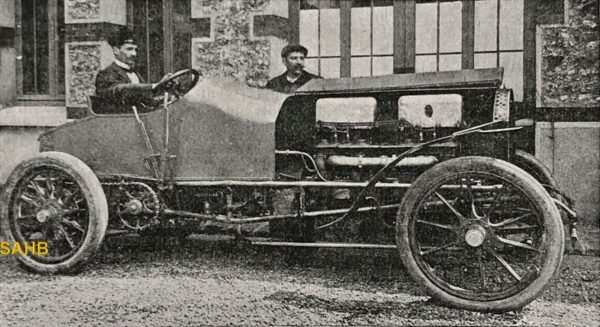
On 21 July 1904, on the beach at the Ostende Automobile Week, the French driver Louis Rigolly set a world land speed record of 103.561 mph. He was the first man to drive a car at over 100 miles an hour.
The car he drove is seen here: a 13.5-litre 4-cylinder Gobron-Brillié racing car. He covered the 1-kilometre course in 21.6 seconds, beating the Belgian Pierre de Caters, who briefly held the world land speed record from the previous May after driving a Mercédès Simplex at 97.25 mph over the same 1-kilometre course.
Societé des Moteurs Gobron-Brillié was founded by the French engineer, Eugène Brillié, and industrialist, Gustave Gobron, at 13, quai de Boulogne, Boulogne-sur-Seine, near Paris, in 1898. The most remarkable feature of these cars lay in their engines. Within each cylinder were two opposed pistons. The lower one drove the crankshaft in the normal way, but the upper one was attached to a yoke with long connecting rods front and rear that descended to the crankshaft. Ignition was triggered as the two pistons approached each other; the inlet and exhaust valves were also placed at this point where the pistons were closest together. The main advantage of this curious arrangement is improved balance of forces in the engine – and at least three other vehicles used opposed pistons for this reason. The Scottish Arrol-Johnston arranged cylinders horizontally in their early cars (from 1895 to at least 1905), driving a single crankshaft below the cylinders through rockers. As late as 1950 Commer introduced a 2-stroke diesel engine with the same configuration, to power its lorries, thus allowing a ‘cab-forward’ layout with better visibility. The French Bardon company (1900-1903) achieved even more perfect balance from horizontal cylinders driving two separate crankshafts, geared together.
Early Gobron-Brillié engines were fed by a revolving petrol distributor instead of a carburettor, with fuel regulated by a drip-feed. This enabled a wide variety of fuels to be used. These first cars also mounted their engines at the rear on a triangular tubular chassis, with chain drive.
Brillié left the company at the end of 1903, at which point it is said that the design was changed to a more conventional pressed-steel ladder-frame chassis, front engine (still with opposed pistons) and carburettor. Our Snapshot, however, clearly shows a tubular frame on this racing machine.
Around 1906-1908, road-going Gobron-Brilliés ranged in size between a 4-cylinder 24/35hp and a 6-cylinder 60/75hp of 11.4 litres. After World War I the Brillié name was dropped, and by 1922 engines had become conventional 1.5-litre units supplied by Chapuis-Dornier. The company steadily declined, and declared bankruptcy in 1930.
Photo courtesy of The Richard Roberts Archive: www.richardrobertsarchive.org.uk







Leave a Comment